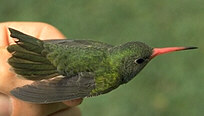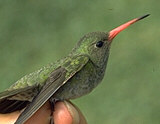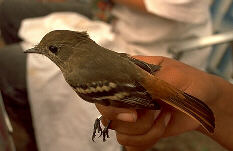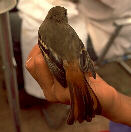

"Solutions" to mysteries from South America
Compiled by Sjoerd Mayer.
Click on the little photos to see bigger versions.
Not songs of Whiskered Owlet Xenoglaux loweryi
Two recordings by © Jon Hornbuckle, of unseen nocturnal birds or animals, heard and recorded on several nights in forest at altitudes of 1800 to 2200 meters, at Abra Patricia, San Martín, Peru, in November 1998.
A Louisiana State University ornithological expedition to the Abra Patricia area tape recorded the song of Xenoglaux, and it is very different from these songs (click here to hear it on Daniel Lane's website). Daniel Lane (who made the confirmed recording) wrote about Jon Hornbuckle's recordings: "The voice does sound immensely like an Amazonian bamboo rat (Dactylomys sp.), and given the prevelence of Chusquea at the sites, I can believe that there may be a congener here (and given that it seems no one has ever tried to trap small mammals here, the fact that this would be an undescribed species of rat is not hard to believe)" - on the BirdingPeru message board: http://groups.yahoo.com/group/Birdingperu/message/1780.
Female Gilded Sapphire Hylocharis chrysura
Two photos made by © Jon Hornbuckle. Same bird, which was netted in the Beni Biological Station, in July or August 1998.
"Solved" by Joe Tobias (joetobias22@hotmail.com) in April 2005.
Young male White-flanked Antwren Myrmotherula axillaris
© Jon Hornbuckle. Los Fierros, Noel Kempff Mercado NP, Santa Cruz. April 1996.
For a long time, I hesitated between Gray Antwren Myrmotherula menetriesii and White-flanked Antwren M. axillaris. But several people with much more experience than me (with Daniel Lane giving the last push) told me it is a White-flanked Antwren.
Probably a young and/or female White-flanked Antwren Myrmotherula axillaris
Photo taken by Omar Rocha and Kent Smith along the Rio Madre de Dios, Pando, Bolivia, in 1991.
Both Stefan Woltmann and Daniel Lane think this is probably White-flanked Antwren Myrmotherula axillaris.
Both these sounds are made by Stripe-headed Antpitta Grallaria andicola!
This recording on the new "Songs of the Antbirds" CDs, but also the long ascending series on this recording
The first recording was made by Tony Meyer at "Peñas Canyon" in Cuzco. The second recording was made by Niels Krabbe at 4100 m in the Cordillera Blanca, Ancash. Note that the song on the first recording is also present on the second.
Phyllis and Mort Isler in a message on the Birding Peru forum about these two recordings: ".. it is interesting that taxa in the Grallaria rufula complex have two vocalizations, one a "song" (?) which is on the Antbirds CD and the other a rattle type vocalization which we assumed was a call. These two vocalizations may be homologous to those of G. andicola."
Ringed Antpipit Corythopis torquata
Photo taken by Omar Rocha and Kent Smith along the Rio Madre de Dios, Pando, Bolivia, in 1991.
Solved by Daniel Lane: "(..) it is a Corythopis torquata (Ringed Antpipit). The size is hard to judge, but it should be about right, the "olive back" and "contrasting gray head" is again the effect of lighting and computer transmission on the photo. The pale tan eye, white throat, pink mandible, and overall shape all agree with Corythopis. It is unfortunate that the bird's wing is obscuring the underparts in this photo".
Agitated calls of Western Wood-Pewee Contopus sordidulus
Recording by Bennett Hennessey of an unidentified Contopus Flycatcher, made at 1800 m in the Bolivian Andes, near the border with Peru.
Paul Coopmans, Richard C. Hoyer, Daniel Lane, and Curtis Marantz all told me these are calls of Western Wood-Pewee C. sordidulus.
Bennett's recording notes:
"09h15 09NOV01, 1800 m, Tokoaque research site, footpath to Moxos, Landslide clearing where bird is calling at edge of the
forest. Singing ind. of pair was seen looking like Contopus fumigatus (calls of less volume could be of other ind.).
After the recording, I broadcasted to the same ind. prerecorded song of Contopus borealis,
C. fumigatus (Bolivian Andes), C. virens, C. sordidulus and C. cinereus- none of which sounded
much like the recorded bird. There was no evident response to playback, neither an approach nor a change in behaviour pattern.
I then did playback of this individual's song, which illicited a strong response to playback with a fast approach and a
2-3 minute searching behaviour. Middle montane forest, Base camp at 2000, WCS, WWF and Instituto de Ecologia research site
Tokoaque (S 14°37’05 W 68°57’06), PN Madidi, Dept. La Paz."
Female White-winged Black-Tyrant Knipolegus aterrimus


© Susan Davis. This bird was netted in the botanical garden of Santa Cruz city.
Identified by Mark Pearman.
Probably Short-crested Flycatcher Myiarchus ferox
Photo made by © Jon Hornbuckle in the Beni Biological Station, in August 1995.
Daniel Lane argued that this is probably Short-crested Flycatcher Myiarchus ferox, and not Swainson's F. M. swainsoni (but he isn't absolutely sure, as the colors on the photo may not be 100% accurate).
Almost certainly Thrush-like Schiffornis Schiffornis turdinus
These photos were made by © Stefan Woltmann at Cocoli in Panama (09.05N,79.79W).
They are put under Brownish Flycatcher on the "Birds of Bolivia 2.0" CD-ROM, but I put them on the "mysteries" web page after Mark Pearman expressed doubt about the identification. The "solution" was finally found by Daniel Lane: almost certainly Thrush-like Schiffornis Schiffornis turdinus ("I agree with Mark Pearman that this bird is not a Cnipodectes, but it is not Sapayoa either. My guess is Schiffornis turdinus. It is unfortunate that all three photos show the bird from the same angle, as crown and bill shape are not really easy to see in any of them. However, the bird has a more brownish color overall (assuming the colors are not heavily distorted in color), which does not agree with Sapayoa (which is entirely olive green), and more importantly, the flanks appear to be a paler grayish color, which fits Schiffornis turdinus and not Sapayoa (which has brighter yellow-olive belly if it is paler than the rest of the plumage). Of course bill shape would be the clincher (broad bill in Sapayoa), but as I said, one cannot really discern this from the photos. A male Sapayoa would be easy to identify by its yellow crown patch, but this is not present in females. The bird is not Cnipodectes as the eye color seems wrong (pale brown-gray rather than darker chestnut or red... the former does agree with Schiffornis, and the latter is standard for Cnipodectes), there are no pale edges visible on the tertials and the wing shape and general "cleanliness" of the bird is wrong (Cnipodectes never look like they've been having a good day, they're always ratty!), the tail is too short, there are no rictal bristles visible, and the (lower) mandible is not uniformly pale pink or orange").
Lawrence's Thrush Turdus lawrencii
© Jon Hornbuckle. Beni Biological Station, 8 August 1996. Bird was caught in a degraded fragment of seasonally-inundated forest. Appeared to be a first year bird, from its pointed tail feathers and buff-tipped secondary coverts.
Solved by Robin Restall.
Click here to send your comment to Sjoerd Mayer.